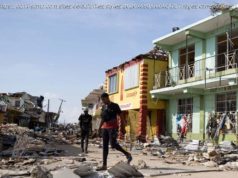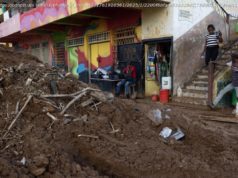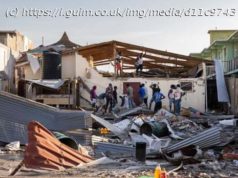The storm surge in the Carolinas could be deadly. But for inland towns, it’s the water that will fall afterward that could really bring disaster.
GREENVILLE, N. C. — Hurricane Florence began its brutish slow-motion collision with the Carolina coasts Thursday, with beach towns cowering under the first bands of lashing rain. Storm surge and winds were expected to reach 100 miles per hour by sometime Friday.
At the same time, residents and emergency personnel throughout inland North and South Carolina were working under the grim assumption that the Category 2 storm’s pounding of the coastline would be only the first powerful punch in a fight that could go many rounds and last for many days. It will play out not only among stilted beach cottages and seaside resorts, but also in workaday towns and cities much farther west.
“This may be the first time we’ve experienced such a two-punch from these kind of conditions,” said South Carolina’s governor, Henry McMaster, at a news conference on Thursday, speaking about evacuations along the coast as well as the possibility of rain-triggered landslides in the mountains.
Florence is proving to be a lumbering giant, with cloud cover as large as the Carolinas themselves. If, as expected, it dawdles over the region, the storm could drop rainfall of 20,30 or even 40 inches in some areas. Anxiety is especially high over the fate of all of that water, which will have to go somewhere.
That means a cascading series of complications for a city like Greenville, a handsome college town of 92,000 people set on the banks of the Tar River.
Greenville lies far inland, a few score miles west of the Atlantic Ocean, but it is connected to the sea by the Tar River, which eventually becomes the Pamlico River as it widens out and flows into the Atlantic.
On Thursday, as billowing, dark heather clouds loomed overhead, the city’s spokesman, Brock Letchworth, said Greenville’s first concern is that Florence could drop enough water to create immediate flash flooding.
But he said the city was also worried about a massive salty storm surge roaring westward up the river from the Atlantic. Finally, there is the problem of all the rainfall on the rest of the state, which would have to eventually drain eastward out toward the ocean.
City and county officials have stationed swift-water rescue groups in place, including teams of wildlife officers from Indiana. Police have begun going door to door in the lowest-lying areas suggesting that residents get out. Some 300 people were already using five Pitt County shelters.
But Mayor P. J. Connelly said that the river flooding might not occur for days, if at all, given how capricious the storm’s track had proven to be. For the moment, the future for Greenville seemed as though it was written on water.
“A lot of what we do afterward is based on what the storm brings,” Mr. Connelly said, “which could be a lot of uncertainty.”
[ Are you in the path of Hurricane Florence? We want to hear from you .]
The drama was considerably more tangible on Thursday in the coast-hugging city of Wilmington, N. C., where, at midday, winds whipped ocean spray across sand dunes on nearby barrier islands. City streets began to empty as residents made final preparations. The storm was expected to make landfall at around 8 a.m. Friday near Wrightsville Beach, on Wilmington’s eastern shoulder.
“The winds of Hurricane Florence are upon us,” said Steven Still, director of emergency management for New Hanover County, which includes Wilmington.
By early Friday morning, winds were expected to increase to 100 miles per hour or more “and will stay with us for a considerable period of time,” Mr. Still said.
Emergency officials said they were particularly concerned about the powerful storm surge, predicted to reach 9 to 10 feet on North Carolina’s barrier islands, possibly producing dangerous flooding of rivers, bays, sounds and estuaries throughout the region.
Officials continued to urge people to stay inside their homes and to leave low-lying areas prone to flooding.
“We’re not going to be able to come out and get you if you have an emergency during the storm,” said Mayor Bill Saffo of Wilmington.
Mr. Saffo warned that the effects of the storm could last for several days or more, with widespread power outages, flooded roads and homes, and mountains of windblown debris.
“It’s going to pound us for quite some time,” he said.
In South Carolina, state officials urged residents to follow evacuation orders as the storm begins to make landfall and to take Florence seriously, even though its winds had weakened some.
“These are your last few hours of safe evacuation,” said Katie Geer, a spokeswoman for the South Carolina Department of Insurance. “You should not pay attention to the category of the storm. Just because it’s weakening does not mean it’s not posing a serious threat.”
Authorities said 3,917 people have moved into shelters in South Carolina, with three shelters completely occupied. The state still has space for more than 31,000 people across 60 shelters.
Rick Luettich, director of the University of North Carolina’s Institute of Marine Sciences, who has a front-row seat for the storm in Morehead City, N. C., said that the story of Florence would almost certainly play out in other areas further inland.
“We think about the front-facing beaches, and those are the front lines,” he said. “But they oftentimes have sand dunes and other protections that can hold.”
“As you get up into the estuaries, as you work your way up into the coastal plain, there’s no defense,” he said. “The water from the ocean backs up into those systems.”
Some areas that may feel they were spared when the hurricane first passes might experience serious flooding from the winds on the back end of the storm, which will still be pushing water up into the crenelated North Carolina coastline.
In Greenville, they know the storm is coming. In Greenville, although some residents have been asked to evacuate their homes, there are others — perhaps hundreds of them — who might not be advised to leave until long after the hurricane is gone and the water finally comes flowing back down the Tar River, headed for the ocean.
“We’ve got time. We’ve probably got about a week, which seems strange,” said Eric Griffin, the fire rescue chief for the city of Greenville. “What you will have is, the storm will come through, it’ll be nice and sunny and bright, and all of a sudden you’ll say, well, ‘What’s going on?’ And we’ll say, ‘The water’s rising.’ And the water rises pretty quickly. You could see maybe a foot every couple of hours or so.”
Mr. Letchworth, the city spokesman, said the possibility of immediate flash flooding seemed to be getting worse in recent years, the result of a building boom spurred in part by the expansion of the 29,000-student East Carolina University. That has meant more pavement and other impermeable surfaces, he said, and more places that flood that have not flooded before.
The school canceled classes earlier this week, in part to encourage students to go home.
Start
United States
USA — Events As the Winds Come, Towns in Hurricane Florence’s Path Fear the Floods






